Cody Blakeney
Does your data spark joy? Performance gains from domain upsampling at the end of training
Jun 05, 2024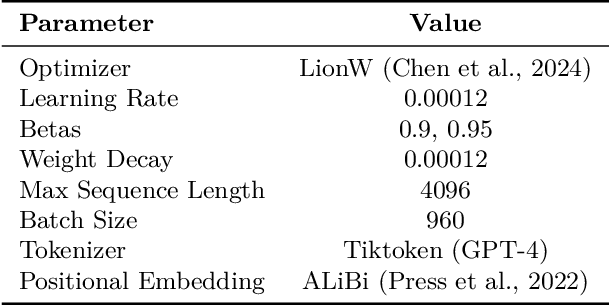



Abstract:Pretraining datasets for large language models (LLMs) have grown to trillions of tokens composed of large amounts of CommonCrawl (CC) web scrape along with smaller, domain-specific datasets. It is expensive to understand the impact of these domain-specific datasets on model capabilities as training at large FLOP scales is required to reveal significant changes to difficult and emergent benchmarks. Given the increasing cost of experimenting with pretraining data, how does one determine the optimal balance between the diversity in general web scrapes and the information density of domain specific data? In this work, we show how to leverage the smaller domain specific datasets by upsampling them relative to CC at the end of training to drive performance improvements on difficult benchmarks. This simple technique allows us to improve up to 6.90 pp on MMLU, 8.26 pp on GSM8K, and 6.17 pp on HumanEval relative to the base data mix for a 7B model trained for 1 trillion (T) tokens, thus rivaling Llama-2 (7B)$\unicode{x2014}$a model trained for twice as long. We experiment with ablating the duration of domain upsampling from 5% to 30% of training and find that 10% to 20% percent is optimal for navigating the tradeoff between general language modeling capabilities and targeted benchmarks. We also use domain upsampling to characterize at scale the utility of individual datasets for improving various benchmarks by removing them during this final phase of training. This tool opens up the ability to experiment with the impact of different pretraining datasets at scale, but at an order of magnitude lower cost compared to full pretraining runs.
Perplexed by Perplexity: Perplexity-Based Data Pruning With Small Reference Models
May 30, 2024Abstract:In this work, we investigate whether small language models can determine high-quality subsets of large-scale text datasets that improve the performance of larger language models. While existing work has shown that pruning based on the perplexity of a larger model can yield high-quality data, we investigate whether smaller models can be used for perplexity-based pruning and how pruning is affected by the domain composition of the data being pruned. We demonstrate that for multiple dataset compositions, perplexity-based pruning of pretraining data can \emph{significantly} improve downstream task performance: pruning based on perplexities computed with a 125 million parameter model improves the average performance on downstream tasks of a 3 billion parameter model by up to 2.04 and achieves up to a $1.45\times$ reduction in pretraining steps to reach commensurate baseline performance. Furthermore, we demonstrate that such perplexity-based data pruning also yields downstream performance gains in the over-trained and data-constrained regimes.
LoRA Learns Less and Forgets Less
May 15, 2024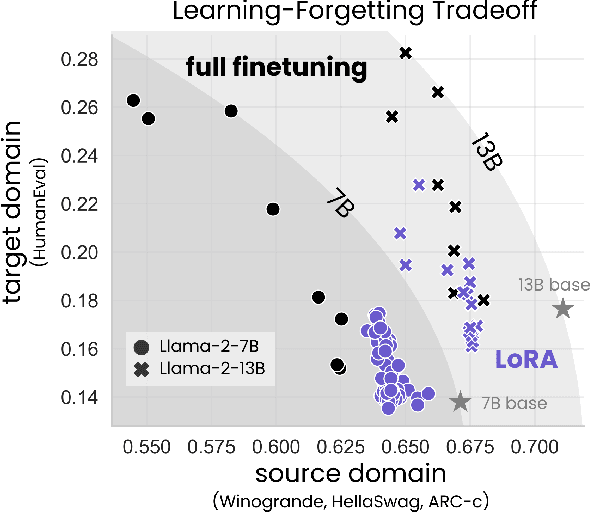

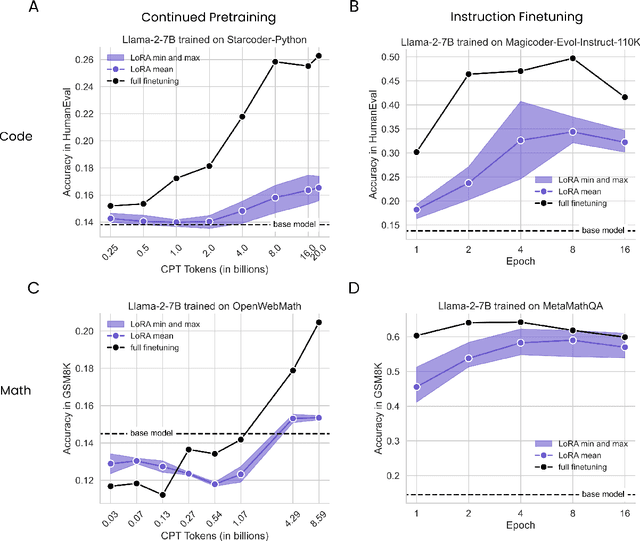

Abstract:Low-Rank Adaptation (LoRA) is a widely-used parameter-efficient finetuning method for large language models. LoRA saves memory by training only low rank perturbations to selected weight matrices. In this work, we compare the performance of LoRA and full finetuning on two target domains, programming and mathematics. We consider both the instruction finetuning ($\approx$100K prompt-response pairs) and continued pretraining ($\approx$10B unstructured tokens) data regimes. Our results show that, in most settings, LoRA substantially underperforms full finetuning. Nevertheless, LoRA exhibits a desirable form of regularization: it better maintains the base model's performance on tasks outside the target domain. We show that LoRA provides stronger regularization compared to common techniques such as weight decay and dropout; it also helps maintain more diverse generations. We show that full finetuning learns perturbations with a rank that is 10-100X greater than typical LoRA configurations, possibly explaining some of the reported gaps. We conclude by proposing best practices for finetuning with LoRA.
Reduce, Reuse, Recycle: Improving Training Efficiency with Distillation
Nov 01, 2022Abstract:Methods for improving the efficiency of deep network training (i.e. the resources required to achieve a given level of model quality) are of immediate benefit to deep learning practitioners. Distillation is typically used to compress models or improve model quality, but it's unclear if distillation actually improves training efficiency. Can the quality improvements of distillation be converted into training speed-ups, or do they simply increase final model quality with no resource savings? We conducted a series of experiments to investigate whether and how distillation can be used to accelerate training using ResNet-50 trained on ImageNet and BERT trained on C4 with a masked language modeling objective and evaluated on GLUE, using common enterprise hardware (8x NVIDIA A100). We found that distillation can speed up training by up to 1.96x in ResNet-50 trained on ImageNet and up to 1.42x on BERT when evaluated on GLUE. Furthermore, distillation for BERT yields optimal results when it is only performed for the first 20-50% of training. We also observed that training with distillation is almost always more efficient than training without distillation, even when using the poorest-quality model as a teacher, in both ResNet-50 and BERT. Finally, we found that it's possible to gain the benefit of distilling from an ensemble of teacher models, which has O(n) runtime cost, by randomly sampling a single teacher from the pool of teacher models on each step, which only has a O(1) runtime cost. Taken together, these results show that distillation can substantially improve training efficiency in both image classification and language modeling, and that a few simple optimizations to distillation protocols can further enhance these efficiency improvements.
Measure Twice, Cut Once: Quantifying Bias and Fairness in Deep Neural Networks
Oct 08, 2021
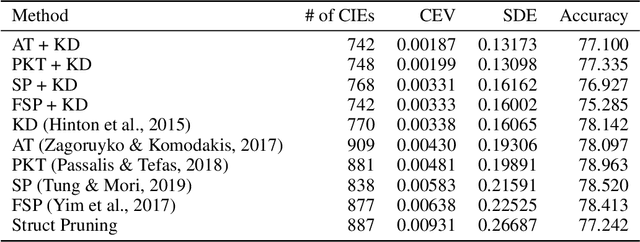
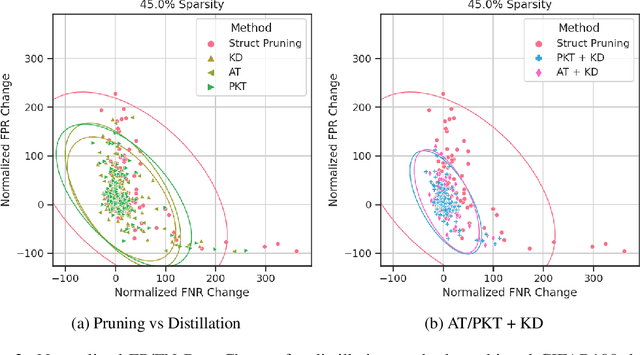
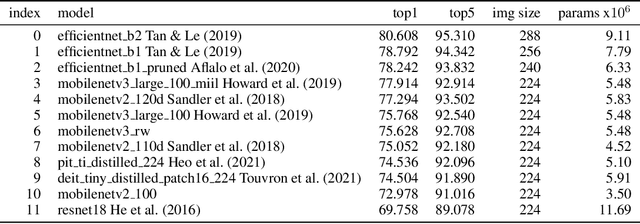
Abstract:Algorithmic bias is of increasing concern, both to the research community, and society at large. Bias in AI is more abstract and unintuitive than traditional forms of discrimination and can be more difficult to detect and mitigate. A clear gap exists in the current literature on evaluating the relative bias in the performance of multi-class classifiers. In this work, we propose two simple yet effective metrics, Combined Error Variance (CEV) and Symmetric Distance Error (SDE), to quantitatively evaluate the class-wise bias of two models in comparison to one another. By evaluating the performance of these new metrics and by demonstrating their practical application, we show that they can be used to measure fairness as well as bias. These demonstrations show that our metrics can address specific needs for measuring bias in multi-class classification.
Simon Says: Evaluating and Mitigating Bias in Pruned Neural Networks with Knowledge Distillation
Jun 15, 2021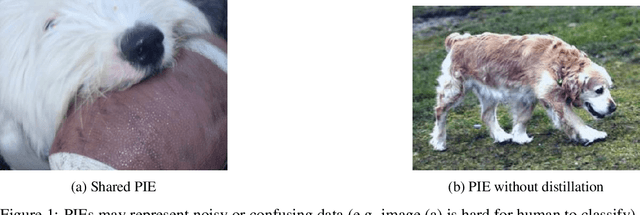

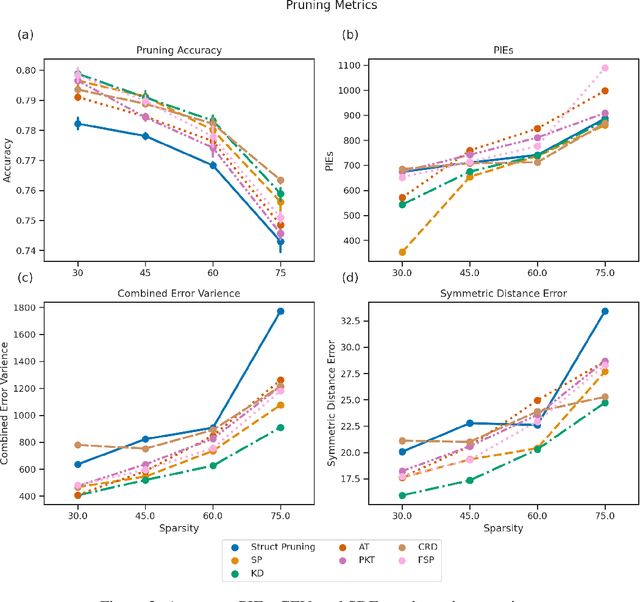
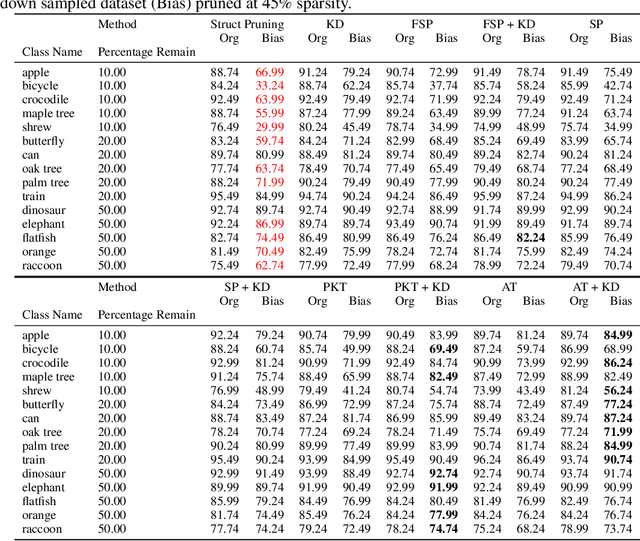
Abstract:In recent years the ubiquitous deployment of AI has posed great concerns in regards to algorithmic bias, discrimination, and fairness. Compared to traditional forms of bias or discrimination caused by humans, algorithmic bias generated by AI is more abstract and unintuitive therefore more difficult to explain and mitigate. A clear gap exists in the current literature on evaluating and mitigating bias in pruned neural networks. In this work, we strive to tackle the challenging issues of evaluating, mitigating, and explaining induced bias in pruned neural networks. Our paper makes three contributions. First, we propose two simple yet effective metrics, Combined Error Variance (CEV) and Symmetric Distance Error (SDE), to quantitatively evaluate the induced bias prevention quality of pruned models. Second, we demonstrate that knowledge distillation can mitigate induced bias in pruned neural networks, even with unbalanced datasets. Third, we reveal that model similarity has strong correlations with pruning induced bias, which provides a powerful method to explain why bias occurs in pruned neural networks. Our code is available at https://github.com/codestar12/pruning-distilation-bias
Parallel Blockwise Knowledge Distillation for Deep Neural Network Compression
Dec 05, 2020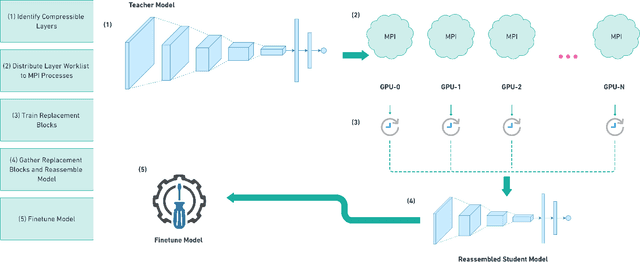
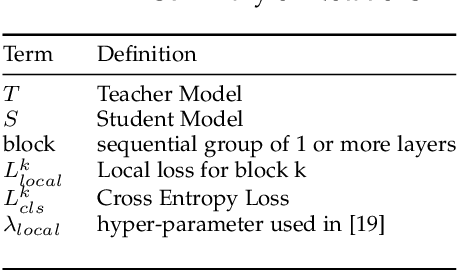
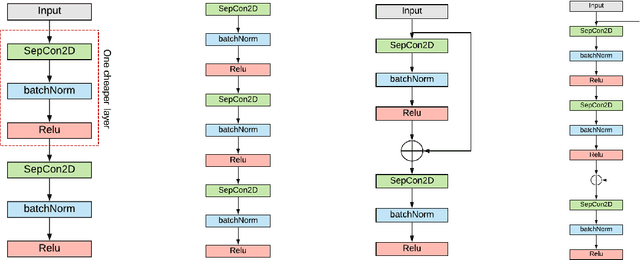

Abstract:Deep neural networks (DNNs) have been extremely successful in solving many challenging AI tasks in natural language processing, speech recognition, and computer vision nowadays. However, DNNs are typically computation intensive, memory demanding, and power hungry, which significantly limits their usage on platforms with constrained resources. Therefore, a variety of compression techniques (e.g. quantization, pruning, and knowledge distillation) have been proposed to reduce the size and power consumption of DNNs. Blockwise knowledge distillation is one of the compression techniques that can effectively reduce the size of a highly complex DNN. However, it is not widely adopted due to its long training time. In this paper, we propose a novel parallel blockwise distillation algorithm to accelerate the distillation process of sophisticated DNNs. Our algorithm leverages local information to conduct independent blockwise distillation, utilizes depthwise separable layers as the efficient replacement block architecture, and properly addresses limiting factors (e.g. dependency, synchronization, and load balancing) that affect parallelism. The experimental results running on an AMD server with four Geforce RTX 2080Ti GPUs show that our algorithm can achieve 3x speedup plus 19% energy savings on VGG distillation, and 3.5x speedup plus 29% energy savings on ResNet distillation, both with negligible accuracy loss. The speedup of ResNet distillation can be further improved to 3.87 when using four RTX6000 GPUs in a distributed cluster.
 Add to Chrome
Add to Chrome Add to Firefox
Add to Firefox Add to Edge
Add to Edge